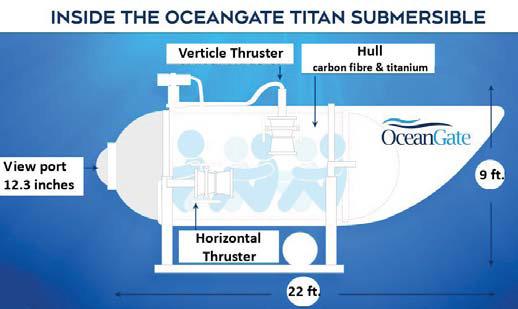Castro County 4-Hers had two days of Rocketry Fun with Texas 4-H STEM Ambassador Spencer Acker heading up the group. Seven youth had the opportunity to learn about lift, drag, thrust and gravity as well as parts of a rocket. As a project, they made straw rockets, stomp rockets and model rockets. They were set to launch the model rockets last Wednesday evening. There is another Rocketry Fun class set for July 5-6 in Nazareth. The classes were made possible through a grant from the Texas AgriWomen Panhandle Chapter. The Titan submersible was reported destroyed by a catastrophic implosion. The pilot and passengers are presumed dead.
The mystery of the missing Titan submersible came to an end on Thursday after Coast Guard Rear Adm. John Mauger confirmed that a debris field was discovered within the search area.
The 21-foot Titan sub had been missing since Sunday, and the countdown began as the oxygen supply was due to run out on Thursday.
The pilot and passengers are considered dead, with the debris field being consistent with a “catastrophic implosion.”
The first piece of wreckage, the tail cone of the Titan, was found by a ROV owned by Massachusetts-based Pelagic Research Services. It was discovered 1,600 feet from the bow of the Titanic. The ROV subsequently found the front-end barrel of the pressure hull.
After the debris was confi rmed, OceanGate, the company which operated the sub, issued a statement that they believed that CEO Stockton Rush and pilot of the vessel, and passengers Shahzada Dawood and his son Suleman Dawood, Hamish Harding, and Paul-Henri Nargeolet, were sadly lost.
Titan dived Sunday to take the group of adventurers on a pricey deep-sea exploration of the century-old wreckage of the Titanic. OceanGate had billed the trip as a chance to “become one of the few to see the Titanic with your own eyes.” Securing a seat on the vessel cost $250,000, according to the company, which touted the trip not as mere tourism but as a dive with a scientific purpose.
Safety concerns had been raised several months earlier by Josh Gates, host of Discovery’s Expedition: Unknown.
“To those asking, Titan did not perform well on my dive. Ultimately, I walked away from a huge opportunity to film Titanic due to my safety concerns,” said Gates.
CBS reporter David Pogue also raised safety concerns after visiting OceanGate’s operations last year. and was submerged about 40 feet in the $1 million submarine when technical issues stopped them from visiting the Titanic. He observed the next day’s expedition from the control room on the ship when the Titan submersible took paying customers down to the ocean floor - but they never reached the Titanic wreckage. Pogue said the Titan was lost for several hours but could still communicate with the control ship over text messages.
Before boarding the sub, Pogue said he was given a tour of the vessel, during which he commented on its “improvised design,” which included lighting from Camping World, an unoffi cial PlayStation controller used to drive the submarine and jerry-rigged interior, noting the custom-built submersible was not subject to any regulatory standards.
Pogue tweeted that a major difference in the recent trip – this time the Titan wasn’t just lost, the submersible stopped communicating with the control ship, and judging from the timeline, it took most of the day before Ocean Gate reported the Titan’s disappearance to the Coast Guard.
Documents show Ocean-Gate was repeatedly warned there could be catastrophic safety problems by the way it was developed. The company has been making yearly voyages to the Titanic since 2021.
David Lochridge, Ocean-Gate’s director of marine operations, who was ultimately fired at the company, wrote an engineering report in 2018 that said the craft under development needed more testing and that passengers might be endangered when it reached “extreme depths,” according to a lawsuit filed that year in U.S. District Court in Seattle.
Lochridge’s concerns primarily focused on the company’s decision to rely on sensitive acoustic monitoring — cracking or popping sounds made by the hull under pressure — to detect flaws, rather than a scan of the hull.
“Sounds only show when a component is about to fail — often milliseconds before an implosion — and would not detect any existing flaws prior to putting pressure onto the hull,” Lochridge’s counterclaim said.
Further, the craft was designed to reach depths of 13,123 feet, where the Titanic rested. But, according to Lochridge, the passenger viewport was only certified for depths of up to 4,265 feet, and OceanGate would not pay for the manufacturer to build a viewport certified for 13,123 feet.
OceanGate also received another warning in 2018 from the Marine Technology Society, which describes itself as a professional group of ocean engineers, technologists, policymakers and educators.
In a letter to Stockton Rush, the society said it was critical that the company submit its prototype to tests overseen by an expert third party before launching in order to safeguard passengers.
Rush had refused to do so. Rush was piloting the Titan that went missing and imploded.



